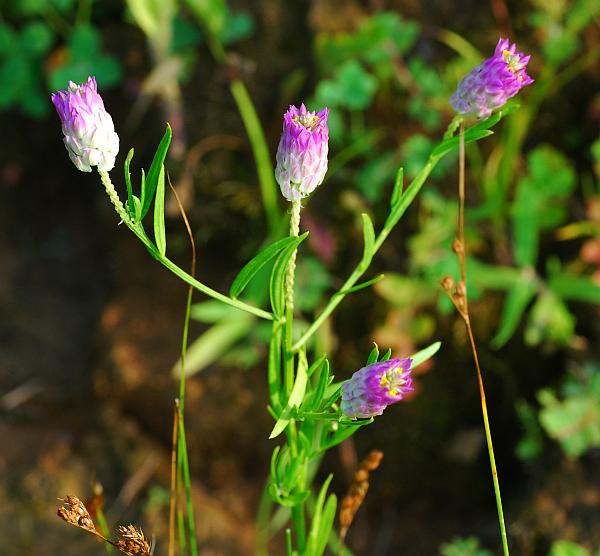Polygala sanguinea L.
Field Milkwort

Native
CC = 4
CW = 3
MOC = 75
© SRTurner
Polygala sanguinea L.Field Milkwort | |
 |
Native CC = 4 CW = 3 MOC = 75 |
© SRTurner |
|
Family - Polygalaceae Habit - Annual forb with slender taproot. Stems - Ascending to erect, to 40 cm, unbranched or few-to several-branched toward the tip, glabrous, not glaucous, green to olive green, carinate to 4-angled near apex.
Leaves - Alternate, relatively closely spaced, sessile or very short-petiolate, linear to linear-elliptic, 1-5 mm wide, glabrous, the margins entire, the plants appearing leafy at flowering and fruiting.
Inflorescences - Terminal dense headlike or spikelike racemes 1.0-2.5 cm long. Pedicels to 1 mm long.
Flowers - Wings (lateral sepals) 4.5-6.0 mm long, ovate to nearly oval, white, usually slightly to strongly pinkish-tinged toward the tip, often with an inconspicuous slender pale green central band. Corollas zygomorphic, of 3 petals, these 2.5-2.7 mm long, white, usually slightly to strongly pinkish-tinged toward the tip, rarely greenish white, the fused portion 1.5-2.2 mm long. Stamens 8, the filaments fused into a tube just inside the keel that is split longitudinally along the upper side, also fused to the corolla tube, the anthers attached at their bases, usually yellow, the pollen usually shed by apical pores or short slits. Pistil 1 per flower, of 2 fused carpels. Ovary superior, 2-locular, often flattened, the placentation axile (appearing more or less apical). Style 1, often curved toward the tip, usually unequally 2-lobed near the tip, the upper lobe bearing a capitate stigma, the other lobe sterile, with a fringe of hairs. Ovule 1 per locule.
Fruits - Capsules 2.0-2.5 mm long, obovoid-orbicular, not or only slightly flattened. shallowly notched at the tip. Seeds 1.5-1.7 mm long, the aril 1.0-1.2 mm long, papery, with 2 linear lobes. Flowering - May - October. Habitat - Glades, upland prairies, upland forest openings, pastures, fields, ditches, railroads, and roadsides. Origin - Native to the U.S. Lookalikes - None. Other info. - This small but pretty species is found throughout most of Missouri, less commonly in a few south-central and far northwestern counties. Beyond Missouri its range extends throughout most of the Midwest and into New England and Canada. When in flower, the plant is easily identified by its unique inflorescences, which have a tendency to be most strongly pinkish near the apex. Photographs taken at Taberville Prairie, MO., 6-7-03, and at Bethel Prairie, MO., 7-4-03 (DETenaglia); also at Shaw Nature Reserve, Franklin County, MO, 7-22-2008, Crowley's Ridge Conservation Area, Stoddard County, MO, 8-14-2009, Hughes Mountain Natural Area, Washington County, MO, 5-21-2012, Don Robinson State Park, Jefferson County, MO, 6-25-2017, and at Western Star Flatwoods, Phelps County, MO, 6-23-2023 (SRTurner). |